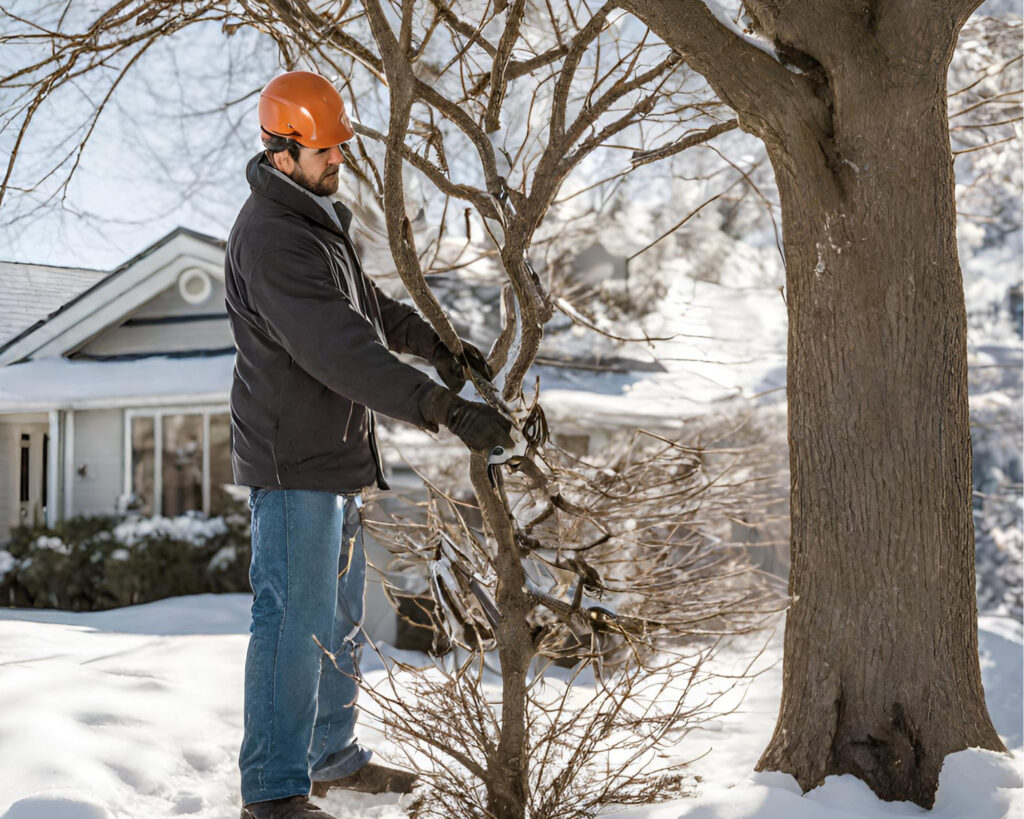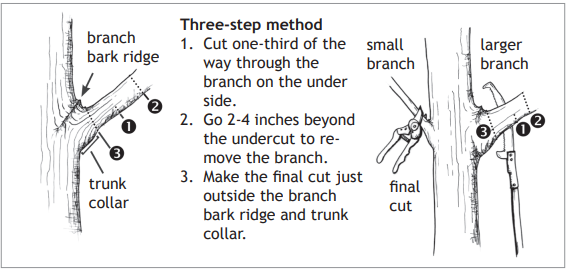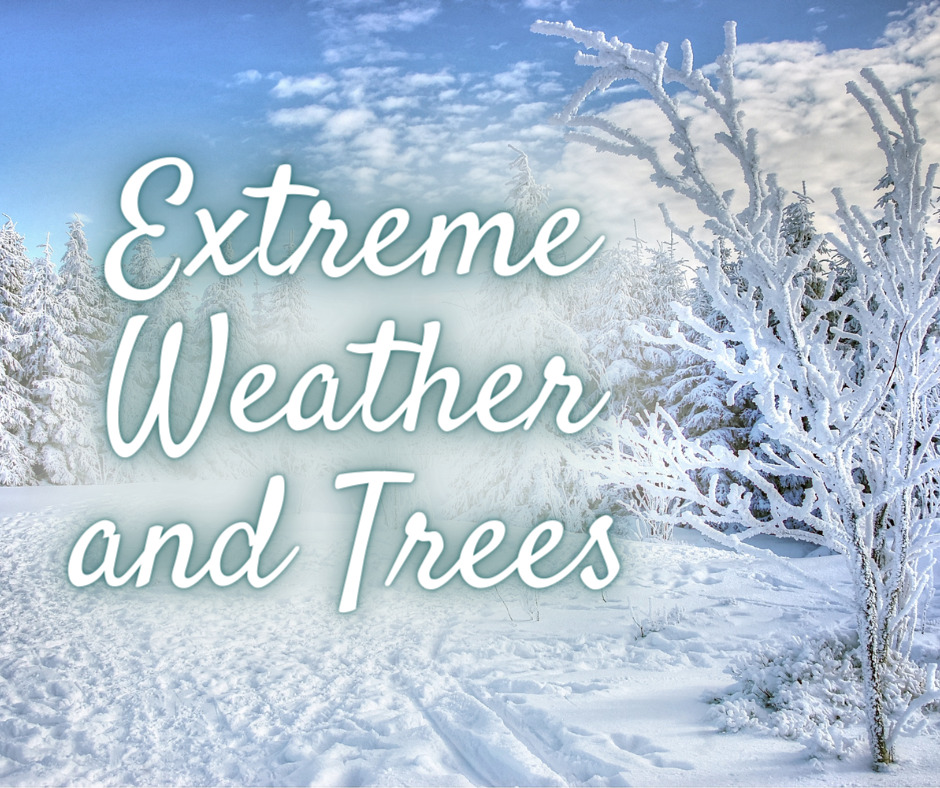Author: Suzanne Sauls, with contributions from Stephen Johnson and Catherine Wissner, all Laramie County Master Gardeners

Whether you’re a seasoned green thumb or a budding gardener, trimming your trees can be a game-changer. Pruning isn’t just about aesthetics (although it does wonders for a plant’s appearance). By snipping away those pesky diseased, damaged, or dying branches, you’re giving your plants a healthy boost. But wait, there’s more! Property protection is a part of the package. When those wild Wyoming winds blow or snow piles up, your pruned trees will stand tall, like the superheroes of your yard. Now, I know what you’re thinking because I’ve been there myself: “What if I mess up?” Pruning can be intimidating, but we’re here to guide you through the snip-and-clip dance. So, grab those pruning tools, put on your gloves, and let’s prune like pros!
Evergreens, Deciduous Trees, and Fruit Trees
Most evergreens need little to no pruning, but you may choose to go ahead and take the loppers to them just to control their size or promote bushier new growth (the University of Colorado Extension Master Gardeners’ GardenNote on evergreen pruning techniques is a good resource to check out for more information on evergreen pruning).[1] As for deciduous trees, the Wyoming State Forestry Division recommends winter pruning for those susceptible to fire blight, such as the mountain ash or hawthorn.[2] And fruit trees?…the University of Wyoming (UW) has the inside scoop: prune most fruit trees (except sweet cherries) while they’re still dormant. If your fruit tree has a natural spreading habit (like peach, European plum, or tart cherry), prune towards an open center, vase-shaped appearance. But if your fruit tree prefers to stand tall and proud (like apples and pears), consider leaving the central leader in place (one main trunk extending from the base to the top of the tree). In both these styles, don’t forget to scrutinize the lateral branches–prune to ensure even spacing which will help reduce fruit load stress and clear obstacles for more sunshine to reach the tree and fruit. Finally, removing large branches (should not be bigger than the adjacent branches on the same limb) that shade the more productive fruit-bearing limbs may also help.[3]
Now Is the Time
The best time to prune your tree is in Winter or Early Spring because trees are dormant—you’ll have a better view of its structure without its leaves and the tree is less stressed or susceptible to pests and diseases through your pruning cuts. A mild, dry day is ideal–recommend identifying a 4- to -5-day window where the temperatures are nice enough to get outside. And if temps are above 40 degrees F, take some time to do a little winter watering—your plants will thank you! And FYI, as for recurring pruning, check out the Wyoming State Forestry Division’s nifty tree pruning timeline tucked into their Wyoming Tree Owner’s Manual publication [4]:
- At Tree Planting: Keep it simple–focus on removing any broken or dead branches, and if eliminate extra leaders. Over-pruning a tree can add stress and who needs that when you’re just getting settled into your new neighborhood?
- 2 Years Later: Your tree is growing up! Go for a light pruning every year to every-other-year for the first 10 years.
- After a Decade: Now your tree has swagger–prune once every 1-3 years (for fruit trees), once every 4-7 years (for deciduous shade trees), or as needed (for evergreens).
Tips & Techniques
In general, you should consider the following questions when determining whether or not a branch should be pruned from the tree:
- Are any branches Damaged, Diseased, or Dead (“the three Ds”)?
- Are there any downward-growing branches?
- Are any branches crossing or growing inward to the trunk?
- Are there any suckers coming up from the roots or low on the trunk?
- Are there any vertical branches (water sprouts)?
- Does the tree have more than one central leader?
If any of these questions are answered “Yes,” then that branch will be a good candidate for pruning. Most trees, when pruned regularly, only require the use of hand pruners (bypass type), but thicker branches may require use of a Lopper (bypass type), hand saw, or pole saw. When pruning, the best technique is to look for the trunk collar (may also be referred to as the branch collar). Begin the cut close to, but just outside of the trunk collar, and angle down and away from the trunk to allow the tree to seal over the cut. Pruning outside of the trunk collar may also encourage new growth from a bud on the stub. The Wyoming State Forestry Division recommends supporting the branch with one hand while you make the cut to prevent the bark from ripping. If the branch is too large to support, they recommend using the three-step method illustrated below.[5]

Laramie County Master Gardener Stephen Johnson provides this tip if your property is rabbit-prone: “If an abundance of rabbits exists, leave removed branches on the ground. This may feed the rabbits through the winter and save the tree from being girdled by them.”
Common Mistakes to Avoid
It is not all fun and games when pruning trees, especially in chilly weather, so it’s best to take a few precautions:
- Over-pruning: do not remove more than 25% – 30% of your tree’s live branches at any one time (good news: any dead or damaged branches you remove do not count against this percentage). Avoid tunnel vision—make some cuts, walk around the tree, make some more cuts, then step back and look at the whole tree from all angles—ensure your cuts result in a balanced look.
- Using dirty, blunt tools: ensure your pruners and loppers are ready to take on your tree. Blunt tools may leave jagged wood ends which could become entry points for increased damage. To avoid spreading diseases between trees, we also recommend sterilizing your tools after each cut.
- Use care around sharp objects and heights: If you must use a ladder, ask a friend to spot you – ensure the ground is even when you set up your ladder and don’t get overzealous in reaching to make cuts. If in doubt, contact a licensed arborist for help with large or high-risk pruning tasks. The City of Cheyenne Urban Forestry Division maintains a list of certified arborists on its website (http://www.cheyennetrees.com/arborists.php).
It’s the Small Victories (And Additional Resources)
As we look ahead to the warmth of summer, each cut is an investment, and our trees (and harvests) will thank us for this winter TLC. It’s the small victories—the branches trimmed just right, the diseased and dead limbs removed, and the promise of new growth in the season to come. Speaking of victories, the Laramie County Master Gardeners are inching closer to having our very own YouTube channel where we can demonstrate techniques in articles such as this one! We’ll let you know more in the future, but until then, check out these additional resources on tree pruning:
- “Improve your winter pruning practices,” by Jacob Mares, UW Barnyards & Backyards Fall 2023
- “Winter is the best time for pruning trees,” by Donna Cuin, UW College of Agriculture and Natural Resources, originally published in the Barnyards & Backyards April 2010 Newspaper Insert
- “Correct Pruning can revitalize landscapes,” by Diana Cochran and Karen Panter, UW Barnyards & Backyards Winter 2009
- University of Wyoming Extension YouTube Channel, “From the Ground Up” Series
[1] Colorado Master Gardener GardenNote #617, Pruning Evergreens, May 2023, available for download from https://cmg.extension.colostate.edu/Gardennotes/617.pdf.
[2][4][5] Wyoming Tree Owner’s Manual, revised and printed by the Wyoming State Forestry Division with permission from USDA Forest Service, Northeastern Area, 2021, available for download from https://www.uwyo.edu/barnbackyard/_files/documents/resources/trees/tree-owners-manual-toprint-edited2021.pdf.
[3] Apple, Pear Trees can survive and thrive in Wyoming, by Chris Hilgert, University of Wyoming Barnyards & Backyards Magazine, Spring 2016, available for download from https://www.uwyo.edu/barnbackyard/_files/documents/magazine/2016/spring/applepear0416.pdf

